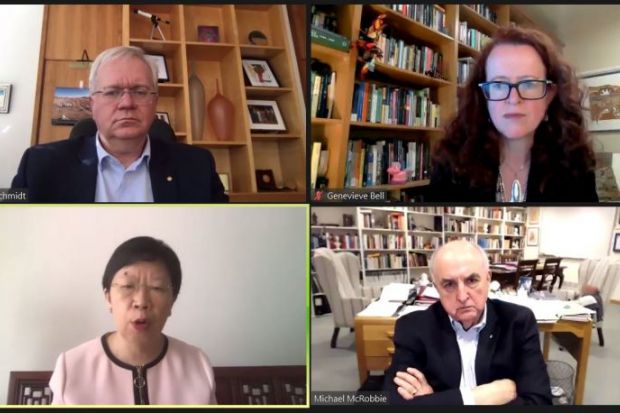The Covid-19 crisis may have accelerated universities’ adoption of online education, but it has also confirmed the durability of the bricks-and-mortar model, an Australian forum has heard.
Indiana University president Michael McRobbie said the past few months had strengthened his scepticism about predictions that traditional education would be supplanted by purely online approaches. “One thing we have learned definitively is that students do not want to be locked in their parents’ basement for four years doing their degree online,” he told a webinar presented by the Australian National University (ANU).
“Sociologists will claim that 50 per cent of what a student learns, they learn from interaction with other students and aspects of their environment outside the classroom. There is a desperation for young students to get back to a college education.”
A Melbourne-born computer scientist and ANU alumnus, Professor McRobbie spent a decade as Indiana’s chief information officer before becoming president in 2007. He said that as the university prepared for its bicentennial year last winter, he had been contemplating how to make technology “even more pervasive” throughout the institution.
“Little did we know what was in store for us,” he reflected.
Singapore Management University, which was gearing up for its 20th year, also had to pivot very quickly to the use of educational technology. The institution’s president, Lily Kong, said the experience had served “to strengthen my conviction about what we use technology for”.
“It’s easy to have lots of talking heads on screen,” Professor Kong told the forum. “Students can listen to whatever material is being spewed out. But…how do we use technology to personalise learning? How do we use technology to deepen interaction and collaboration, rather than to take away from it?”
Professor Kong said the experience had also highlighted the importance of “synchronous interaction” in online learning. “It’s entirely possible to put lots of material online [that] students can access in their own time, at their own pace. But really what the students are looking for, and what they really learn from, is that interaction with somebody else on the other side of the screen.”
She said her university had “politely” declined invitations from partner institutions to send its students on virtual exchanges. “If they’re not able to go where you are, they’re not immersed in another country [or] culture. As a Chinese saying goes, ‘You can read 1,000 words, but it’s not the same as seeing it for yourself just the one time.’ At the end of the day, technology can supplement – can maybe even enable for some – but it doesn’t replace.”
ANU vice-chancellor Brian Schmidt said the crisis had clarified how digital approaches could enhance education: “And it’s made very clear where digital is a second cousin to the intense, in-person experience – how to use digital successfully, and how to not use digital in the future.”
Professor Schmidt said students “don’t like coming to thousand-person lectures very often. But when they do come on campus, the thing our students really [value] is that in-person engagement where you interrogate ideas. So, let’s spend our time doing that.
“Google can outsource me on the big, standard deliverer digital stuff. But they can’t outsource my world-leading professors who can have a one-on-one conversation about exploring ideas anew.”
Register to continue
Why register?
- Registration is free and only takes a moment
- Once registered, you can read 3 articles a month
- Sign up for our newsletter
Subscribe
Or subscribe for unlimited access to:
- Unlimited access to news, views, insights & reviews
- Digital editions
- Digital access to THE’s university and college rankings analysis
Already registered or a current subscriber? Login










